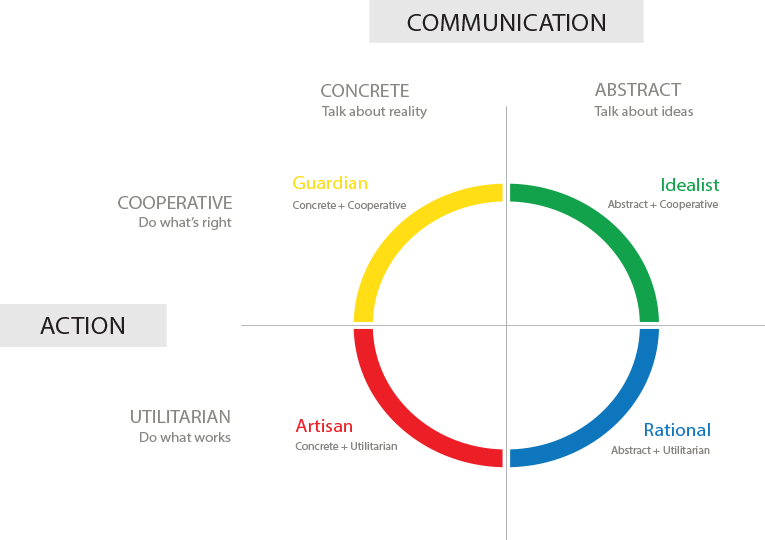Understanding Temperament
https://keirsey.com/temperament-overview/
The Keirsey Temperament Matrix.
May 9, 2023
*The opinions expressed within the content are solely the author’s and do not reflect the website’s or its affiliates’ opinions and beliefs.*
Dating back to philosophers such as Hippocrates, Plato and Aristotle, the concept of four different personality types, or temperaments, has persisted throughout history. Nowadays, this idea is more widespread than ever, with online personality tests available with a simple Google search.
One of the most widely accepted models is the Keirsey model, developed by Dr. David Keirsey, author of the book “Please Understand Me” and “Please Understand Me II.” The Keirsey model discusses how people are born with different predispositions, which later become observable behavior patterns. To put it simply, people are inherently different from one another in the way they perceive, interact and think about the world around them. These differences can be organized into four temperaments: Artisans, Guardians, Idealists and Rationals. The easiest way to explain and think about each temperament is through the metaphor of different “lands” in which each of the temperaments resides.
Artisans play in “Adventure Land.” This land is all about stimulation and keeping life exciting. Artisans have the most heightened awareness of their physical senses, “to see, hear, taste, touch, smell . . . ”—which makes their experience feel even more amazing. In this land, adaptability is key. Everything is in the spur of the moment. This is the place of pleasure, risk-taking and instant gratification.
Guardians organize in “Checkbox Land.” Here, it is all about getting things done. They have the highest need for closure; checking items off the to-do list is what makes life feel worthwhile and productive for them. An empty checkbox makes them feel unreliable and uneasy while getting things done makes them feel like they are being of service, thus, making them respectable. For a Guardian, accomplishing their day-to-day tasks allows them to sleep at night.
Idealists dream in “Potential Land.” Captivated by possibilities and growth, Idealists yearn to maximize their full potential and they want to help others do the same. “Potential Land” is about the fulfillment of one’s hopes and dreams; the pursuit of meaning, purpose and fulfillment. It’s about finding one’s identity and understanding one’s true calling to make a difference in the world.
Rationals analyze in “Complexity Land.” Everything here is about having a big-picture perspective, and nothing is as simple as it seems. Reality is viewed as being far more complex, having many layers. Problems are dissected, analyzed, reframed and diagnosed. Solutions are well thought through and implemented systematically in a strategic manner. Taken to an extreme, when you ask a Rational what time it is, they will respond by telling you how to build a clock.
To the untrained eye, it may seem as though these descriptions belong in a Harry Potter book. However, once learned, temperament becomes more apparent. The easiest way to think of it is through what’s called the Temperament Matrix.
As shown here, people communicate and act differently based on their temperaments. Communication is divided into two categories: concrete and abstract. Action is divided into two categories as well: utilitarian and cooperative.
The following explanations are taken directly from the Keirsey website linked earlier in the article:
Concrete Communication: Some people talk primarily about the external, concrete world of everyday reality: facts and figures, work and play, home and family, news, sports and weather – all the who-what-when-where-and-how’s of life. Artisans and Guardians are concrete.
Abstract Communication: Others fixate on the internal, abstract world of ideas: theories and conjectures, dreams and philosophies, beliefs and fantasies—all the why’s, if’s and what-might-be’s of life. Rationals and Idealists are abstract.
Cooperative Action: A person may behave in a cooperative or socially acceptable manner. They try to do the right thing by keeping with agreed-upon social rules, conventions and codes of conduct, and only later do they concern themselves with the effectiveness of their actions. Guardians and Idealists are cooperative.
Utilitarian Action: Others still may have a utilitarian or pragmatic perspective on the world. They focus on results and what achieves their objectives as effectively and efficiently as possible. Only afterward do they check to see if they are observing the rules or going through the proper channels. Artisans and Rationals are utilitarian.
By understanding how people are fundamentally different in the ways that they think and not basing our assumptions of others on the idea that they think in the same way as we do, people can begin to connect more effectively. Whether it’s communicating with family members, friends or teachers, achieving our combined goals is easier once we know why people act the way they do. In an ironic sense, acknowledging our differences brings about unity. We may never be wizards and witches, but we can write our own stories, assisted by the universal system of temperament.
Writer’s Note: The purpose of this article is not to thoroughly and fully explain everything there is to know about temperamental theory. However, it is to provide a starting point for people who may be interested in changing their lives and changing the way they connect to the world and other people.





